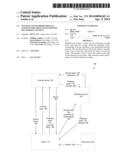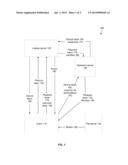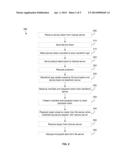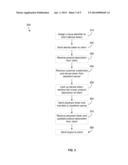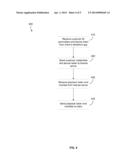Patent application title: SYSTEMS AND METHODS FOR FAST STARTUP STREAMING OF ENCRYPTED MULTIMEDIA CONTENT
Inventors:
William Amidei (La Jolla, CA, US)
William Amidei (La Jolla, CA, US)
Jason Braness (San Diego, CA, US)
Kourosh Soroushian (San Diego, CA, US)
Kourosh Soroushian (San Diego, CA, US)
Eric Grab (San Diego, CA, US)
Eric Grab (San Diego, CA, US)
IPC8 Class: AH04L2906FI
USPC Class:
726 29
Class name: Prevention of unauthorized use of data including prevention of piracy, privacy violations, or unauthorized data modification access control by authorizing client
Publication date: 2014-04-03
Patent application number: 20140096269
Abstract:
Methods and systems to allow for the streaming of media from a file
server to a client, where the streaming occurs concurrently with the
execution of an information security protocol. The security protocol
allows the client to securely receive one or more keys that allow the
client to access the media. This permits a user to access the media
sooner than would otherwise be possible, while allowing timely
performance of security related processing.Claims:
1. A method of media streaming, comprising: at a client, sending a device
token to a storefront server, wherein the device token uniquely
identifies the client; receiving a playback token and a manifest from the
storefront server; and concurrently receiving streamed encrypted media
from a file server and engaging in an information security protocol with
a license server, wherein the information security protocol results in
the client's ability to access the media.
2. The method of claim 1, wherein the manifest comprises a synchronized multimedia integration language (SMIL) file.
3. The method of claim 1, wherein said engaging in the information security protocol comprises: sending the playback token to the license server; and receiving one or more cryptographic keys from the license server.
4. The method of claim 3, wherein the one or more cryptographic keys allow the client to authenticate itself to a file server from which the media is streamed.
5. The method of claim 3, wherein the one or more cryptographic keys allow the client to decrypt the encrypted media.
6. The method of claim 3, further comprising: sending updated device capability information to the license server with the playback token.
7. The method of claim 1, further comprising: at the client, receiving the device token from the license server; and sending device capability information to the license server, performed before said sending of the device token to the storefront server.
8. The method of claim 1, wherein customer identification (ID) parameters are sent with the device token to the storefront server.
9. The method of claim 1, wherein the manifest and playback token are obtained by the storefront server from the license server after the storefront server sends the device token received from the client, to the license server.
10. The method of claim 1, wherein the playback token and manifest are cached at the client after said receipt from the storefront server.
11. A system for media streaming, the system including a client that comprises: a processor; and a memory in communication with said processor, said memory for storing a plurality of processing instructions configured to direct said processor to: send a device token to a storefront server, wherein the device token uniquely identifies the client; receive a playback token and a manifest from the storefront server; and concurrently receive streamed encrypted media from a file server and engage in an information security protocol with a license server, wherein the information security protocol results in the client's ability to access the media.
12. The system of claim 11, wherein the manifest comprises a synchronized multimedia integration language (SMIL) file.
13. The system of claim 11, wherein said instructions configured to direct said processor to engage in the information security protocol comprise instructions configured to direct said processor to: send the playback token to the license server; and receive one or more cryptographic keys from the license server.
14. The system of claim 13, wherein the one or more cryptographic keys allow the client to authenticate itself to a file server from which the media is streamed.
15. The system of claim 13, wherein the one or more cryptographic keys allow the client to decrypt the encrypted media.
16. The system of claim 13, wherein said plurality of processing instructions is further configured to direct said processor to: send updated device capability information to the license server with the playback token.
17. The system of claim 11, wherein said plurality of processing instructions is further configured to direct said processor to: receive the device token from the license server; and send device capability information to the license server, performed before the sending of the device token to the storefront server.
18. The system of claim 11, wherein customer ID parameters are sent with the device token to the storefront server.
19. The system of claim 11, wherein the manifest and playback token are obtained by the storefront server from the license server after the storefront server sends the device token received from the client, to the license server.
20. The system of claim 11, wherein the plurality of processing instructions are further configured to direct said processor to: cache the playback token and manifest at the client after the receipt from the storefront server.
21. A computer program product comprising a non-transitory computer useable medium having control logic stored therein, the computer control logic comprising logic to cause a processor in a client to: send a device token to a storefront server, wherein the device token uniquely identifies the client; receive a playback token and a manifest from the storefront server; and concurrently receive streamed encrypted media from a file server and engage in an information security protocol with a license server, wherein the information security protocol results in the client's ability to access the media.
22. The computer program product of claim 21, wherein the manifest comprises a synchronized multimedia integration language (SMIL) file.
23. The computer program product of claim 21, wherein said logic to cause the processor to engage in the information security protocol causes the processor to: send the playback token to the license server; and receive one or more cryptographic keys from the license server.
24. The computer program product of claim 23, wherein the one or more cryptographic keys allow the client to authenticate itself to a file server from which the media is streamed.
25. The computer program product of claim 23, wherein the one or more cryptographic keys allow the client to decrypt the encrypted media.
26. The computer program product of claim 23, wherein the computer control logic further comprises logic to cause the processor to: send updated device capability information to the license server with the playback token.
27. The computer program product of claim 21 wherein the computer control logic further comprises logic to cause the processor to: receive the device token from the license server; and send device capability information to the license server, performed before said sending of the device token to the storefront server.
28. The computer program product of claim 21, wherein customer ID parameters are sent with the device token to the storefront server.
29. The computer program product of claim 21, wherein the manifest and playback token are obtained by the storefront server from the license server after the storefront server sends the device token received from the client, to the license server.
30. The computer program product of claim 21, wherein the computer control logic further comprises logic to cause the processor to: cache the playback token and manifest at the client after the receipt from the storefront server.
Description:
BACKGROUND
[0001] The streaming of media from a server is now a common practice. There is, however, a need to control who may access the media and the circumstances under which the media is accessed. Typically, a user and/or his computing device may need to be authorized to access certain media. A user may need to be a valid account holder, and may need to have paid for the media, for example.
[0002] As a result, media owners and distributors now commonly implement digital rights management (DRM) in an effort to control access. DRM may include the use of cryptography for purposes of encrypting and decrypting media, and for authentication purposes. To implement this, key distribution and key management protocols may be put into place. The appropriate key(s) need to be provided securely to the authorized party, and to that party only. With the proper key(s), an authorized user may then decrypt and otherwise access a media stream.
[0003] While this may allow for a secure transaction, such processing may be time-consuming. Communications may have to take place between a client and a trusted agent of the media owner or distributor (e.g., a license server) in order to establish a user's right to access the media and to secure the media from unauthorized users. The time and effort required to implement such a secure transaction may diminish a user's experience. The user chooses to access certain media, and then typically wants to see the media with minimal delay. DRM processes, while necessary, may slow down media delivery.
BRIEF DESCRIPTION OF THE DRAWINGS/FIGURES
[0004] FIG. 1 is a block diagram of a system that implements the processing described herein, according to an embodiment.
[0005] FIG. 2 is a flowchart illustrating processing at a client, according to an embodiment.
[0006] FIG. 3 is a flowchart illustrating processing at a license server, according to an embodiment.
[0007] FIG. 4 is a flowchart illustrating processing at a storefront server, according to an embodiment.
[0008] FIG. 5 is a block diagram illustrating a computing system of the client, according to an embodiment.
[0009] In the drawings, the leftmost digit(s) of a reference number identifies the drawing in which the reference number first appears.
DETAILED DESCRIPTION
[0010] An embodiment is now described with reference to the figures, where like reference numbers indicate identical or functionally similar elements. While specific configurations and arrangements are discussed, it should be understood that this is done for illustrative purposes only. A person skilled in the relevant art will recognize that other configurations and arrangements can be used without departing from the spirit and scope of the description. It will be apparent to a person skilled in the relevant art that this can also be employed in a variety of other systems and applications other than what is described herein.
[0011] The systems and processes described herein allow for the streaming of media from a file server to a client, where the streaming occurs concurrently with the execution of an information security protocol. This permits a user to access the media sooner than would otherwise be possible, while allowing timely performance of security related processing.
[0012] The overall processing of the system described herein is shown in FIG. 1, according to an embodiment. Initially, a client 110 interacts with a license server 120. The license server 120 assigns a unique identifier to the client 110, where this identifier takes the form of a device token 150. The device token 150 may be received from license server 120 at client 110. In an embodiment, device token 150 is saved in persistent storage in client 110. The client 110 may also have a product description 155, which represents device capability information about the client device 110. The license server 120 may receive and use this information to determine the types of multimedia streams that client 110 is able to process. In an embodiment, the product description 155 can be cached at the license server 120 and associated with the device token 150.
[0013] When the client 110 requests a media stream, the device token 150 is sent to a storefront server 130. In an embodiment, this may take place via a storefront application running on client 110 (not shown). In an embodiment, one or more customer identification parameters 165 are also sent to the storefront server 130. These parameters may include device-specific identification information, such as a MAC address, which the storefront server 130 may use to retrieve user account information (such as a user's email address, user ID, and/or password). In an alternative embodiment, the customer ID parameters 165, as sent to the storefront server 130, may include the actual user ID and password.
[0014] In either case, the user ID, email address, and/or password will eventually be sent from the storefront server 130 to the license server 120 as credentials 170. The storefront server 130 forwards the device token 150 with the credentials 170 to the license server 120. The license server then looks up the device token 150 and reads the last known product description associated with this device token. The license server 120 then provides a playback token 175 and a media manifest 180 to the storefront server 130. As will be described below, the playback token 175 will be used as a mechanism for asserting that the client 110 is authorized to receive the requested media.
[0015] In an embodiment, the manifest 180 is a synchronized multimedia integration language (SMIL) file. The playback token 175 and manifest 180 are then sent by the storefront server 130 to the client 110.
[0016] In an embodiment, the playback token 175 and manifest 180 are provided to logic running in client 110. In an embodiment, this logic is incorporated in a larger set of software modules referred to herein as a playback stack (not shown). Logic in the playback stack is capable of communicating with the license server 120 and with a file server 140. The playback stack begins streaming media (shown as stream 195) from the file server 140. Concurrently, the playback stack of client 110 initiates an information security protocol with the license server 120. In an embodiment, this protocol takes the form of a secure session with the license server 120. In this secure session, the playback token 175 is sent to the license server 120. In an embodiment, an updated product description 185 is also sent to the license server 120. One or more cryptographic keys 190 may then be provided by the license server 120 to client 110. In an embodiment, the key(s) 190 are used to decrypt the encrypted media in stream 195. In an embodiment, one or more of key(s) 190 may themselves be encrypted, requiring their decryption before use. One or more of key(s) may also be used in an authentication process with file server 140 in an embodiment. As would be understood by a person of ordinary skill in the art, the cryptographic processes used herein may use symmetrical or asymmetrical keys, and the processing may incorporate public key operations such as the Rivest Shamir Adleman (RSA) or Diffie Hellman processes, and/or conventional cryptography such as the Data Encryption Standard (DES) or the Advanced Encryption Standard (AES) algorithms.
[0017] In an embodiment, the playback token 175 and the manifest 180 may be cached at client 110. This allows these items to be used by the client 110 to initiate a secure session with the license server at a later time.
[0018] Processing at the client 110 is illustrated in FIG. 2, according to an embodiment. At 205, a device token is received at the client from the license server. At 210, the device token is saved in persistent memory. At 215, the device token is made available to a storefront application that is local to the client. At 220, the client sends to the license server a product description that describes the capabilities of the client.
[0019] At 225, the client requests playback of a media stream. At 230, the storefront application sends customer identification parameters and the device token to the storefront server. At 235, the client receives a manifest and a playback token from the storefront server. As noted above, in an embodiment the manifest is a SMIL file. In an embodiment, the playback token and the manifest may be cached at the client for later use, as noted above. At 240, the manifest and playback token are presented to the client's playback stack. At 245, the playback stack streams media from the file server while concurrently establishing a secure session with the license server using the playback token. As described above, the establishment of this secure session includes sending the playback token to the license server and may also include sending an updated product description to the license server. At 250, as part of the secure session, one or more keys may be received from the license server. At 255, encrypted data from the file server may be decrypted at the client.
[0020] Processing at the license server is illustrated in FIG. 3, according to an embodiment. At 310, the license server assigns a unique identifier to the client, embodying the identifier in a device token. At 320, the device token is provided to the client. At 330, the license server receives a product description from the client, where the product description describes the capabilities of the client and, by extension, describes the media streams that may be processed by the client.
[0021] At 340 the license server receives customer credentials and the device token from the storefront server. Recall that these items are provided to the storefront server by the client when the user requests playback. At 350, the last known product description of the client is accessed at the license server. In an embodiment, this description is located at the license server by using client identification information in the device token. At 360 the playback token and a manifest are sent to the storefront server. The storefront server will provide these to the client.
[0022] The license server and the client then engage in a secure session. As part of this session, the playback token is received at the license server from the client. In an embodiment, the license server also receives an updated product description from the client. At 380, the license server sends one or more keys to the client. The keys allow the client to decrypt the encrypted media, the streaming of which was initiated by the client concurrently with the initiation of the secure session.
[0023] Processing at the storefront server is illustrated in FIG. 4, according to an embodiment. When a user requests playback, the storefront server receives customer ID parameters and the device token from the client at 410. In an embodiment, these items are provided by a storefront application at the client. At 420, the storefront server sends customer credentials and the device token to the license server. At 430, the storefront receives the license server's response, i.e., the playback token and manifest. At 440, the storefront server sends the playback token and manifest to the client. In an embodiment, the playback token and the manifest may be cached at the client as noted above. This allows these items to be used by the client to initiate a secure session with the license server at a later time.
[0024] One or more features disclosed herein may be implemented in hardware, software, firmware, and combinations thereof, including discrete and integrated circuit logic, application specific integrated circuit (ASIC) logic, and microcontrollers, and may be implemented as part of a domain-specific integrated circuit package, or a combination of integrated circuit packages. The term software, as used herein, refers to a computer program product including at least one computer readable medium having computer program logic stored therein to cause a computer system to perform one or more features and/or combinations of features disclosed herein. The computer readable medium may be transitory or non-transitory. An example of a transitory computer readable medium may be a digital signal transmitted over a radio frequency or over an electrical conductor, through a local or wide area network, or through a network such as the Internet. An example of a non-transitory computer readable medium may be a compact disk, a flash memory, or other data storage device.
[0025] A client that performs the processing described above with respect to FIG. 2 may incorporate a programmable computing system. Such a computing system executes software/firmware embodying the above processing. Such a system is shown in FIG. 5, according to an embodiment. The illustrated system 500 may include one or more processor(s) 520 and may further include a body of memory 510. Processor(s) 520 may include one or more central processing unit cores. Memory 510 may include one or more computer readable media that may store computer program logic 540. Memory 510 may be implemented as a hard disk and drive, a removable media such as a compact disk, a read-only memory (ROM) or random access memory (RAM) device, for example, or some combination thereof. Processor(s) 520 and memory 510 may be in communication using any of several technologies known to one of ordinary skill in the art, such as a bus or point-to-point interconnect. Computer program logic 540 contained in memory 510 may be read and executed by processor(s) 520. One or more I/O ports and/or I/O devices, shown collectively as I/O 530, may also be connected to processor(s) 520 and memory 510. In an embodiment, one or more I/O devices 530 are used to receive and/or send communications with the license server, storefront server, and file server.
[0026] In the illustrated embodiment, computer program logic 540 includes storefront app 545, which is responsible for communicating with the storefront server. The storefront app 545 provides the device token and customer ID parameter(s) to the storefront server, and receives the playback token and manifest from this server.
[0027] Computer program logic 540 also includes information security protocol logic 550. This logic module is responsible for initiating and executing a secure session with the license server. As described above, this session includes the sending of a playback token to the license server and the receipt of one or more cryptographic keys. In an embodiment, the key(s) received from the license server may be themselves encrypted, requiring decryption at the client before they may be used.
[0028] Computer program logic 540 also includes streaming logic 560. This logic module is responsible for performing streaming operations in conjunction with the file server. The streaming process includes the use by the client of the above key(s) to decrypt the encrypted streamed media. Other key(s) may be used for authentication purposes with the file server from which the encrypted media stream is received. Some or all of information security protocol logic 550 and streaming logic 560 may be implemented in a playback stack (not shown), as discussed above.
[0029] Methods and systems are disclosed herein with the aid of functional building blocks illustrating the functions, features, and relationships thereof. At least some of the boundaries of these functional building blocks have been arbitrarily defined herein for the convenience of the description. Alternate boundaries may be defined so long as the specified functions and relationships thereof are appropriately performed.
User Contributions:
Comment about this patent or add new information about this topic:
| People who visited this patent also read: | |
| Patent application number | Title |
|---|---|
| 20190325647 | SINGULARITY REDUCTION IN QUADRILATERAL MESHES |
| 20190325646 | Dynamic Selection Mechanism For Interactive Video |
| 20190325644 | SURFACE RECONSTRUCTION FOR ENVIRONMENTS WITH MOVING OBJECTS |
| 20190325642 | COMPUTER PLATFORM FOR POOLING AND VIEWING DIGITAL DATA |
| 20190325641 | System and Method for Simulating Realistic Clothing |

